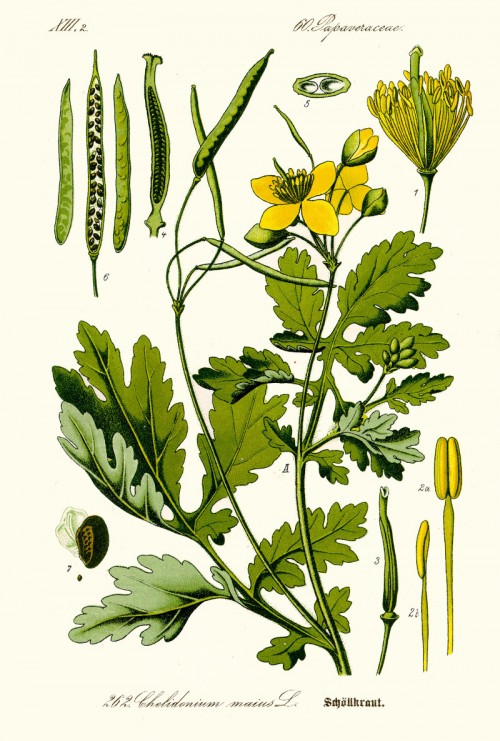Chelidonium majus L. - Papaveraceae - Greater Celandine, Great Celandine, Swallowwort, Schöllkraut
Biennial or perennial herb, up to 70cm tall, native to Eurasia, naturalized in East North America; leaves pinnately lobed, underneath blueish green; flowers yellow with 4 petals, 2 sepals and numerous stamens.
The German Commission E Monographs (a therapeutic guide to herbal medicine) approved C.majus herb (Chelidonii herba) to treat painful cramps of the bile ducts and the gastrointestinal tract.
[Bundesanzeiger 15.5.1985]
http://buecher.heilpflanzen-welt.de/BGA-Kommission-E-Monographien/chelidonii-herba-schoellkraut.htm
„Chelidonium majus L. (Papaveraceae) has a long history as being useful for the treatment of many diseases in European countries. This plant is of great interest for its use also in Chinese herbal medicine. The plant contains, as major secondary metabolites, isoquinoline alkaloids, such as sanguinarine, chelidonine, chelerythrine, berberine and coptisine. Other compounds structurally unrelated to the alkaloids have been isolated from the aerial parts: several flavonoids and phenolic acids. C. majus extracts and its purified compounds exhibit interesting antiviral, antitumour and antimicrobial properties both in vitro and in vivo.“ [Pharmacological activities of Chelidonium majus L. (Papaveraceae). Colombo ML, Bosisio E., Pharmacol Res. 1996 Feb;33(2):127-34]
„Two ethanolic dry extracts from the herb Chelidonium majus L. with a defined content of the main alkaloids (chelidonine, protopine, and coptisisine) and the alkaloids themselves were studied in three different antispasmodic test models on isolated ileum of guinea-pigs. In the BaCl2-stimulated ileum, chelidonine and protopine exhibited the known papaverine-like musculotropic action, whereas coptisine (up to 3.0 x 10(-5) g/ml) was ineffective in this model. Both extracts were active with 53.5% and 49.0% relaxation at 5 x 10(-4) g/ml. The carbachol and the electric field stimulated contractions were antagonized by all three alkaloids. Coptisine showed competitive antagonist behaviour with a pA2 value of 5.95. Chelidonine and protopine exhibited a certain degree of non-competitive antagonism. In the electric field the antagonist activities decreased in the order protopine > coptisine > chelidonine. The concentrations of the chelidonium herb extracts for 50% inhibition of the carbachol and electrical field induced spasms were in the range of 2.5 to 5 x 10(-4) g/ml.“
[Antispasmodic and relaxant activity of chelidonine, protopine, coptisine, and Chelidonium majus extracts on isolated guinea-pig ileum., Hiller, K.O., Ghorbani, M., Schilcher, H., Planta medica, 64(8), 1998, 758-760]
„The characteristic latex also contains proteolytic enzymes and the phytocystatin chelidostatin, a cysteine protease inhibitor. These co-constituents could explain the topical use of greater celandine against warts and moles.“ http://en.wikipedia.org/wiki/Chelidonium_majus
[Chelidocystatin, a novel phytocystatin from Chelidonium majus., Rogelj, B., Popovič, T., Ritonja, A., Štrukelj, B., Brzin, J., Phytochemistry, 49(6), 1645-1649]
Toxicity and pharmacological activity are discussed for several years. http://gjrmi.com/Upload/Apr2013/Biswas%20S%20J.,%20GJRMI%202%284%29_%20238-245.pdf
There are many reports about the hepatotoxic action of Chelidonium extracts. http://www.aerzteblatt.de/pdf.asp?id=34606

Thomé, O.W., Flora von Deutschland Österreich und der Schweiz, Tafeln, vol.2 t.262 (1885)
http://plantgenera.org/species.php?id_species=233252

